NEWS
BACK

Attracting Foreign Investors, Indonesian Government to Develop Tuna Farming Center in Papua
Indonesia's Minister of Marine Affairs and Fisheries, Sakti Wahyu Trenggono, announced that the government will develop offshore tuna farming in the Biak Numfor, Papua. This location will be developed as Indonesia's central tuna export hub.Trenggono mentioned that his party would invite Turkish investors who have successfully developed Atlantic bluefin tuna (Thunnus thynnus) farming to invest in this location. Farming includes fattening tuna from the wild by feeding them to increase their weight.Trenggono said Turkish investors are interested in Biak Numfor, which is located in Cenderawasih Bay, which is rich in biodiversity and part of the Pacific Coral Triangle."This area is most suitable because it borders the northern Pacific waters," Trenggono told Mongabay during an event in Jakarta.In November 2023, KKP inaugurated the first modern fishing village in Biak Numfor with major infrastructure for tuna fisheries, such as ice factories, cold storage warehouses, catch shelters, and piers built by the central government.Other supporting facilities include training centers, clean water installations, drainage, street lighting, wastewater treatment plants, and management offices.Tuna Fishery Potential in Eastern IndonesiaTuna fisheries in Indonesia are a vital livelihood source for coastal communities in Southeast Asian countries and a significant food source for consumers worldwide. Indonesian tuna contributes about 16% of the total global tuna production.Indonesian waters are home to various commercially valuable tuna species, including albacore (T. alalunga), bigeye (T. obesus), and southern bluefin (T. maccoyii).However, excessive wild tuna fishing has led to unsustainable fishing practices. Most fishing areas in the Pacific and Indian Oceans have been fully utilized for various tuna species.The tuna fishery in Biak Numfor is rich in yellowfin tuna (Thunnus albacares). The government estimates this fishery could produce 1 million metric tons of tuna annually.The government also plans to expand direct tuna exports by air from Papua to Japan, one of the largest buyers of Indonesian tuna. Currently, there is only one flight per week for this route. The district fisheries office recorded 29 export shipments between January and August 2023, totaling 140.4 metric tons of tuna from Biak Numfor to Japan.According to KKP data, in 2021, Indonesia caught 791,000 metric tons of tuna, including skipjack, yellowfin, and mackerel tuna (Euthynnus affinis), with a total value of around IDR 22 trillion (US$1.4 billion). About one-fifth of this catch is exported, mainly to the United States, Japan, Thailand, Saudi Arabia, the European Union, Australia, Vietnam, the United Kingdom, and the Philippines.The growth of Indonesian fisheries is part of a global trend in aquaculture, which increased by 527% from 1990 to 2018. In the third quarter of 2021, Indonesian aquaculture production reached 12.25 million metric tons, up 6% compared to the same period in 2020.To maintain sustainable tuna production levels, the government encourages more tuna fisheries to achieve sustainability certification and eco-labeling.The government also regulates fishing, including catch control, monitoring specific species in certain fishing areas, and regulating fishing gear use. Aquaculture is an effort to reduce pressure on wild tuna stocks.Reducing Tuna FishingPreviously, the Indonesian government issued a plan to reduce annual tuna catches by 10% to ensure the fishery's future. This comes in response to declining skipjack (Katsuwonus pelamis) and yellowfin tuna (Thunnus albacares) populations.In a strategic document issued, Indonesia will gradually reduce tuna catch volumes by 10% from 2021 levels over three years. Implementation is planned for 2026 as part of quota and zonal-based fisheries policies.This document extends interim fishing strategies implemented since 2018, covering fishing control regulations and monitoring skipjack, yellowfin, and bigeye tuna (Thunnus obesus) in Indonesian fisheries management areas (WPP-RI)."This is an important step in developing, testing, and implementing utilization strategies for yellowfin tuna, skipjack, and bigeye tuna in Indonesian archipelagic waters," said Agus Suherman, Acting Director General of Capture Fisheries at the Indonesian Ministry of Marine Affairs and Fisheries.Under the United Nations Convention on the Law of the Sea (UNCLOS), ratified by Indonesia in 1985, highly migratory species like tuna must be managed based on international or regional cooperation.However, a large-scale tuna tagging study by The Pacific Community in 2009-2010 indicated that most tuna are recaptured in Indonesian waters.BRIN marine fisheries researcher Fayakun Satria said Indonesia still needs to improve tuna fishery management. This includes ensuring a balance of male and female fish populations and addressing the socioeconomic impacts on tuna fishermen.He said another important aspect is urging neighboring countries like the Philippines and Vietnam to implement tuna fishing strategies."If we reduce catches but they do not, it will affect the success of this harvest strategy. Moreover, catch reduction or control may not be popular among businesses," Fayakun said."If Indonesia does this alone, I am not sure it will be effective."
